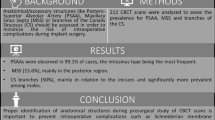Abstract
Purpose
An ongoing clinical trial regarding intra- and post-surgical morbidity in maxillary apicoectomies showed significant higher morbidity for upper canines and palatal roots of upper 1st premolars. Analysis of available presurgical cone beam computed tomography (CBCT)-scans revealed the existence of an unknown bone-canal branching off from the bone-canal or groove of the anterior superior alveolar artery (asaa). Aim of the study was the determination of the contents of this newly found bone canal in human cadaver heads, its prevalence as possible standard anatomical structure and its automatized detection with a contemporary high-resolution TRIUM-CBCT-device in vivo.
Methods
35 human cadaver heads were dissected, the prevalence of the bone-canal determined and its contents analyzed by histology. 835 consecutive routine high-resolution TRIUM-CBCT-scans from routine patients were analyzed by an automatized detection- and tracing-algorithm for in vivo-determination of prevalence of this bone canal. Automatized detection and additional manual tracing were statistically evaluated by SSPS 20.0 software.
Results
The bone-canal was found in 96% of the anatomical specimens, its content identified as artery not described until now and named after the first finder “Arteria Kurrekii”. Automatized tracing of TRIUM-CBCT-scans with additional manual tracing revealed an in vivo prevalence of this newly found artery of 95% (p ≤ 0.05).
Conclusions
The newly found anterior superior palatal alveolar artery (aspaa—“Arteria Kurrekii”) might have the same clinical impact for surgical procedures in the maxilla as the posterior superior alveolar artery (psaa). Its first detection was enabled by high-resolution TRIUM-CBCT devices and prevalence as standard anatomical structure proven in vivo by automatized CBCT-scan analysis.









Similar content being viewed by others
References
Companioni Landín FA, Rigal Bachá Y (2012) Anatomía aplicada a la estomatología. Editorial Ciencias Medicas, La Habana
Elian N, Wallace S, Cho S-C et al (2005) Distribution of the maxillary artery as it relates to sinus floor augmentation. Int J Oral Maxillofac Implants 20:784–787. https://doi.org/10.1111/j.1600-0501.2010.02032.x
Flanagan D (2005) Arterial supply of maxillary sinus and potential for bleeding complication during lateral approach sinus elevation. Implant Dent 14:336–339. https://doi.org/10.1097/01.id.0000188437.66363.7c
Gilroy AM (2015) Anatomy—an essential textbook, latin nomenclature. Thieme, Leipzig
Gordon R (1974) A tutorial on art (algebraic reconstruction techniques). IEEE Trans Nucl Sci 21:78–93. https://doi.org/10.1109/TNS.1974.6499238
Greenstein G, Cavallaro J, Tarnow D (2008) Practical application of anatomy for the dental implant surgeon. J Periodontol 79:1833–1846. https://doi.org/10.1902/jop.2008.080086
Güncü GN, Yildirim YD, Wang HL, Tözüm TF (2011) Location of posterior superior alveolar artery and evaluation of maxillary sinus anatomy with computerized tomography: a clinical study. Clin Oral Implants Res 22:1164–1167. https://doi.org/10.1111/j.1600-0501.2010.02071.x
Hur MS, Kim JK, Hu KS et al (2009) Clinical implications of the topography and distribution of the posterior superior alveolar artery. J Craniofac Surg 20:551–554. https://doi.org/10.1097/SCS.0b013e31819ba1c1
Kamphuis C, Beekman FJ (1998) Accelerated iterative transmission CT reconstruction using an ordered subsets convex algorithm. IEEE Trans Med Imaging 17:1101–1105. https://doi.org/10.1109/42.746730
Kasahara N, Morita W, Tanaka R et al (2016) The relationships of the maxillary sinus with the superior alveolar nerves and vessels as demonstrated by cone-beam CT combined with µ-CT and histological analyses. Anat Rec 299:669–678. https://doi.org/10.1002/ar.23327
Martini F, Timmons MJ, McKinley MP (2000) Human anatomy, 3rd edn. Prentice Hall, New Jersey
Netter FH (2011) Atlas of human anatomy, professional edition. Elsevier, Oxford
Pandharbale AA, Gadgil RM, Bhoosreddy AR et al (2016) Evaluation of the posterior superior alveolar artery using cone beam computed tomography. Pol J Radiol 81:606–610. https://doi.org/10.12659/PJR.899221
Pauwels R, Araki K, Siewerdsen JH, Thongvigitmanee SS (2015) Technical aspects of dental CBCT: state of the art. Dentomaxillofacial Radiol. https://doi.org/10.1259/dmfr.20140224
Rahpeyma A, Khajehahmadi S (2014) Alveolar antral artery: review of surgical techniques involving this anatomic structure. Iran J Otorhinolaryngol 26:73–78
Rosano G, Taschieri S, Gaudy JF, Del Fabbro M (2009) Maxillary sinus vascularization: a cadaveric study. J Craniofac Surg 20:940–943. https://doi.org/10.1097/SCS.0b013e3181a2d77f
Rosano G, Taschieri S, Gaudy JF et al (2011) Maxillary sinus vascular anatomy and its relation to sinus lift surgery. Clin Oral Implants Res 22:711–715. https://doi.org/10.1111/j.1600-0501.2010.02045.x
Rysz M, Koleśnik A, Lewińska B, Ciszek B (2009) The study of arterial anastomoses in the region of the alveolar process and the anterior maxilla wall in foetuses. Folia Morphol (Warsz) 68:65–69
Standring S (2005) The anatomical basis of clinical practice. Elsevier Churchill Livingstone, Edinburg
Wang H, Dong L, O’Daniel J et al (2005) Validation of an accelerated “demons” algorithm for deformable image registration in radiation therapy. Phys Med Biol 50:2887–2905. https://doi.org/10.1088/0031-9155/50/12/011
Wanner L, Manegold-Brauer G, Brauer HU (2013) Review of unusual intraoperative and postoperative complications associated with endosseous implant placement. Quintessence Int (Berl) 44:773–781. https://doi.org/10.3290/j.qi.a29936
West RA, Lanigan DT, Hey JH (1990) Aseptic necrosis following maxillary osteotomies: report of 36 cases. J Oral Maxillofac Surg 48:142–156. https://doi.org/10.1016/S0278-2391(10)80202-2
West RA, Lanigan DT, Hey JH (1990) Major vascular complications of orthognathic surgery: hemorrhage associated with Le Fort I osteotomies. J Oral Maxillofac Surg 48:561–573
Standring S, Ellis H, Wigley C (2005) Gray’s anatomy: the anatomical basis of clinical practice, 39th edn. Elsevier Churchill Livingstone
Acknowledgements
The authors cordially thank Univ.Prof.emer. Dr. Juergen K. Mai, Professor of Neuroanatomy, former Director of the Institute of Anatomy I, H.-Heine-University Duesseldorf, for his advices and support at all stages of the study, his search and professional international inquiries among his colleagues regarding any knowledge of the supposedly newly found artery, provisioning of human cadaver heads, neural network IT-resources and computing time and adaptation of experimental detection algorithms developed, tested and used at his institution without remuneration.
Author information
Authors and Affiliations
Contributions
AK: Project development, Data collection, Data management, Data analysis, Manuscript editing, Anatomy lab work, CBCT lab work. AT: Protocol development, Data collection, Data management, Data analysis, Manuscript writing, CBCT lab work. MK: Data collection, Data management, Data analysis, Manuscript editing, Anatomy lab work.
Corresponding author
Ethics declarations
Conflict of interest
The authors declare that they have no conflict of interest.
Rights and permissions
About this article
Cite this article
Kurrek, A., Troedhan, A. & Konschake, M. Contemporary CBCT diagnostics—discovery of a new artery with possible impact on surgical planning: the anterior superior palatal alveolar artery. Surg Radiol Anat 40, 1147–1158 (2018). https://doi.org/10.1007/s00276-018-2062-9
Received:
Accepted:
Published:
Issue Date:
DOI: https://doi.org/10.1007/s00276-018-2062-9




